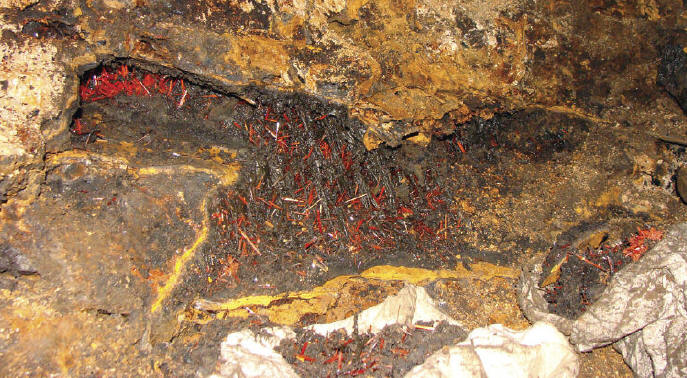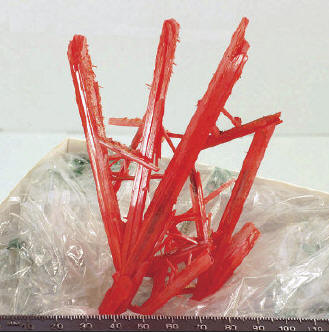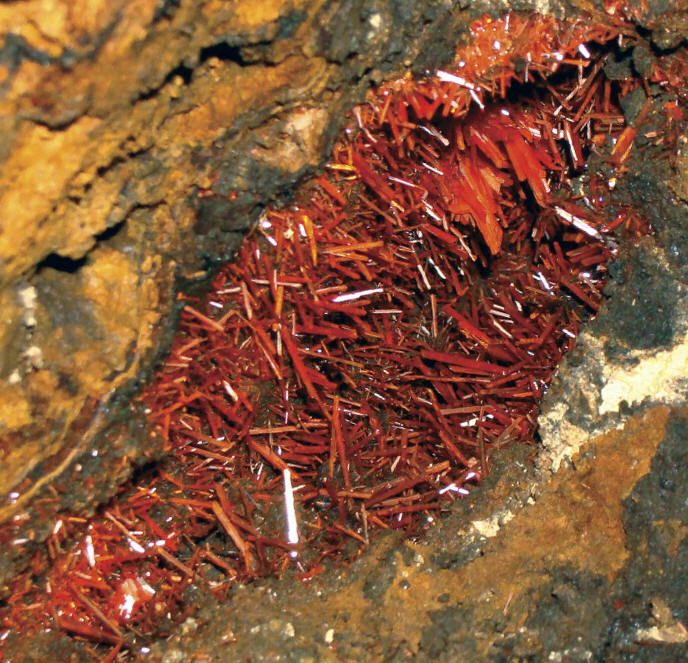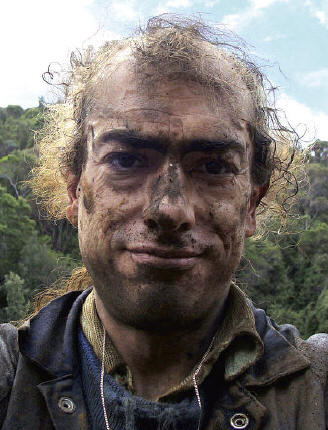
Footwall pocket found before the discovery of 2010 Pocket. Intense weathering causedspecimens to fall apart, leaving mostly single crystals. A. Wright photo.
DundasiteAlthough not forming in spectacularspecimens, dundasite is highly valued from the Adelaide mine as it is the typelocality for this mineral. Locally abundant,it occurs as small, spheroidal clustersbuilt of acicular crystals. Thespheroids can reach 1 cm in diameter,but are typically much smaller. The dundasitecrystals are usually white, but more rarely are blue-green. Dundasitecan occur with other minerals, occasionallyforming a characteristic thin cruston crocoite crystals.


One of the best specimens collected from 2010 Pocket before and after cleaning; crystals up to 13.5 cm. A. Wright photo.
Mimetite
Mimetite crystals as large as 1 cm dooccur, but are typically less than a few millimeters long. Mimetite is mostly lightyellow-green in color, although rarelyoccurring in orange-red or red colors.
The crystals of mimetite form classichabits for the species from tabularto prismatic. Occasionally they arefound with highly distorted and etchedforms.
CROCOITE AND ITS ORIGIN
Crocoite is a rare mineral that wasfirst discovered in Russia and has sinceonly been found in a few other locationsaround the world. Its most notable occurrenceis in the Dundas region on Tasmania’sWest Coast. The Dundas areahas produced the world’s largest andbest quality crocoite crystals in greatabundance. Crocoite specimens from theAdelaide mine are renowned, with piecesdisplayed in museums, private collections,and educational institutions worldwide.
In recognition of the significantcrocoite deposits within the state, it wasofficially proclaimed the Mineral Emblemof Tasmania in 2000.
Crocoite crystals from the Adelaidemine usually exhibit hollow, ”straw”-likeor hoppered forms, and more rarely formchisel pointed crystals (especially in thesmaller crystals).
Color varies from deepred to pale orange-red. The luster can bevariable from highly lustrous to dull. Thecrocoite crystals are usually coveredwith the mixture of gibbsite, Fe-manganeseoxides, and sometimes white, orpale green dundasite. The size of crystalsreach up to 15 cm, but are usually 2-5 cm.The development of crystallized crocoitespecimens is a function of very specialcircumstances and conditions. Themost important among them is the surroundingrocks rich in Cr and Pb, and resultantre-mobilization of those mineralsduring shearing and later oxidizing conditions.
In the specific case of the Dundasregion, we have two basic sources of Cr– firstly the ultramafic ophiolite complex (with chromites), and secondly, otherCr-rich rocks (such as listwanites rich inCr-muscovite). There are also metalliferousveins with galena (source of Pb)occurring in the area. The coincidentalco-occurrence of Cr and Pb is perfect forpossible later crystallization of a specialmineral like crocoite.
Thanks to deep oxidation (over 100m!) by the acidic ground waters in thetropical paleoclimate (probably pH ofwater was <4 during this process), extensivealteration and weathering of primaryrocks took place. During thealteration of serpentine, listwanites, andore minerals (from the veins), lead,chromium and other metals were releasedinto solution.
The remobilizedmetals, along with oxygen, recrystallizedin gossanous cavities, forming free growingcrystals of crocoite and associatedminerals. Because the remobilization ofCr is not so easy over large distances,the crocoites usually grow in the immediatevicinity of mineralized veins. It isworthy of mention that crocoite is stablein low pH conditions, so continued oxidationand weathering has not adverselyaffected crystal quality.

Fragment of 2010 Pocket with deep red crystals of crocoite still in situ, view about15 cm. A. Wright photo.
Additional elements released in thesame weathering process were deposited positedin other minerals. The silver concentratedin chlorargyrite, zinc wasdiffused into numerous minerals, andlead into anglesite, cerussite, pyromorphiteand coronadite as well as crocoite.

Adam Wright – co-owner of Adelaidemine – after day of working in the mine. A. Wright photo.
FAMOUS POCKETS
The first of the famous Adelaidemine crocoite pockets for which wehave recorded history, was found in theearly 1970’s. It was followed twentyyears later by the much larger pocket ofthe early 1990’s. No accurate recordswere kept on the size of the 1970’spocket but several verbal accounts detailit as being a pipe which travelled upwardsfor several meters in length.







 YueGongAnBei 44051102000467
YueGongAnBei 44051102000467


 |
|